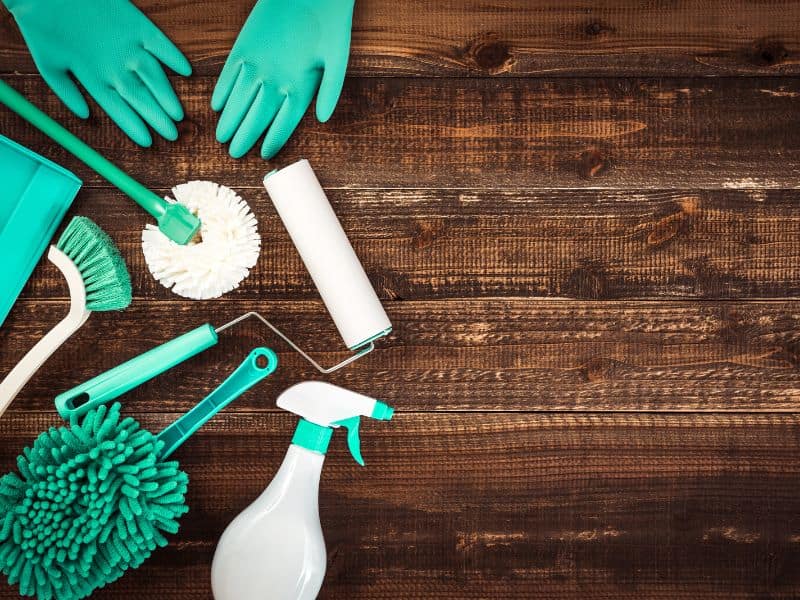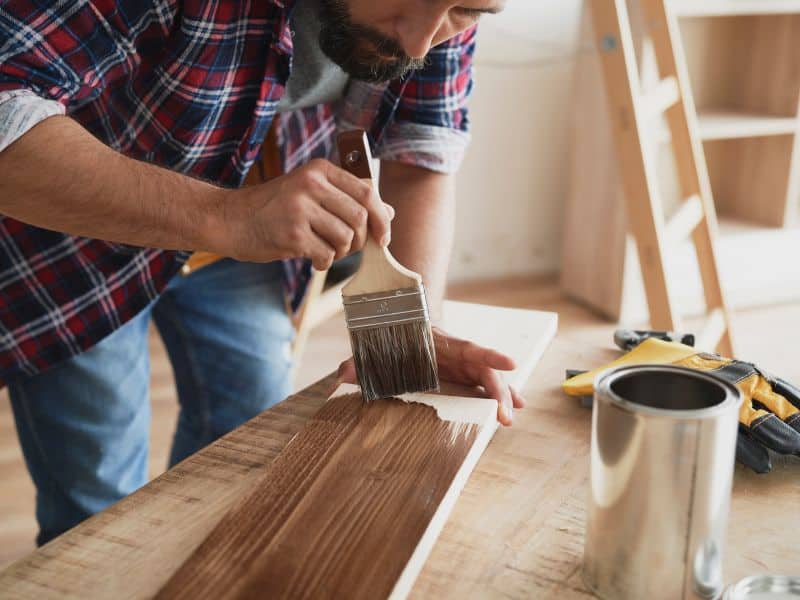How to Disinfect Reclaimed Wood (8 Steps)

Congratulations on choosing reclaimed wood, a greener and prettier option for almost any project!
But before you can use your batch of reclaimed wood to build a countertop or even a floor, you should disinfect it. Thankfully, it’s easier than you might think!
The best way to disinfect reclaimed wood is to scrub it with warm soapy water and a soft bristle brush. Dish soap is a gentle yet effective way to disinfect your reclaimed wood. In addition, you can use borax or vinegar to disinfect it if there’s visible mold. Borax will also kill any insects.
The rest of this article will explain all the steps you need to take to disinfect reclaimed wood without ruining the natural patina.
I’ll also review some common misconceptions and things you should avoid when cleaning reclaimed wood, so read the whole article before starting.
We’ve written a review of the pros and cons of reclaimed wood on the blog if you’re interested in finding out more.
1. Get a Bucket of Warm, Soapy Water and a Brush

Reclaimed wood, sealed or not, is best disinfected with mild soap. My favorite is dish soap, as it’s highly effective yet mild enough to get wood squeaky clean without removing its patina.
So, all you need to get started is a large plastic bucket filled with warm water and a few drops of liquid dish soap. Use about one to two tablespoons per gallon.
The other thing you’ll need is a soft bristle brush. A soft toothbrush will work great if it’s a smaller piece of wood. But if you’re working with large planks, get your largest soft bristle brush.
Something made for cleaning leather or shoes is excellent. However, don’t use a brass bristle brush, as it’ll scratch up the wood and ruin it.
I like the Better Boat Deck Brush (Amazon.com) because it’s made for brushing wood without damaging it. It’s very large, perfect for large and wide planks. It can be screwed onto any 3/4″ thread pole.
2. Hose the Reclaimed Wood Down
If you can, bring the reclaimed wood outside to clean it. If you’re working with small pieces of wood, you can do it in your shower cabin.
Either way, the goal is to remove as much dirt and debris as possible from the wood using only water. Avoid using a pressure washer, as it can easily remove the patina. But more on that later.
When you’re done, your reclaimed wood will be mostly clean. Of course, it’ll absorb some of the water, but that’s what we want because it’ll help us with the next step.
3. Scrub the Reclaimed Wood With Soapy Water

It’s now time to bring out your bucket of soapy water and soft bristle brush. To avoid having uncontrollable amounts of suds, the best way to clean the reclaimed wood is to dip your brush into the bucket. Don’t pour it over the wood because it’ll be tough to get the soap out later will be hard.
Refrain from scrubbing too hard or long on a single spot; it’ll remove the natural patina.
After you’ve gone over every plank, rinse everything thoroughly with clean water. You’ll notice soapy bubbles surfacing as you do this. This is fine, and the plan is working — the soap penetrates the wood.
Repeat this process a couple of times or until the bubbles stop.
4. Use Borax, Hydrogen Peroxide, or Vinegar To Remove Mold
Mold is hazardous for your health. Breathing in moldy air leads to fatigue, nausea, asthma, eye and skin irritations, and even fever. Using a moldy countertop to prepare food is even worse and potentially fatal.
So that’s why you must remove all mold from your reclaimed wood before using it.
It’s usually easy to identify mold on wood as it appears as black, green, or white spots on the surface. And while the dish soap cleaned the wood thoroughly, you should still play it safe and disinfect it.
As Green Orchard Group explains, dish soap will make it easier for borax, vinegar, or hydrogen peroxide to completely kill off the mold as it acts as a surfactant. In other words, it’ll physically lift the mold from the wood but won’t kill it.
This is best done while the reclaimed wood is still wet. Then, it’ll be easier for the solution to penetrate deep into the wood’s pores and clean it from the inside.

You can use borax or 3% hydrogen peroxide if you want to get it super clean or if you notice termites or other insects crawling on the wood. The key is to avoid using too much — two tablespoons per gallon is more than enough. On the other hand, using too much will bleach the wood.
As borax turns into hydrogen peroxide when combined with water, you don’t need to use both. Just use a 3% hydrogen peroxide solution instead.
You can also use vinegar, which has antimicrobial properties but is less effective. Only use it if you can’t get your hands on borax or hydrogen peroxide. Create a 50/50 solution of water and vinegar.
Whichever solution you use, here’s what you should do with it:
- Lay out your reclaimed wood on a flat surface with a small gap between the planks.
- Spray or pour the borax/hydrogen peroxide/vinegar solution over the wood.
- Flip the planks and repeat.
- Wait 1–2 hours for the solution to kill the mold.
- Rinse with clean water.
5. Wipe Down With a Lint-free Cloth

Grab a lint-free cloth and pat the wood dry. It’s essential to use a lint-free cloth because if you use a regular cloth, the sharp and uneven edges of the wood will catch it and snag small pieces off. Also, avoid wiping or circular motions, as the wood can easily tear holes in the cloth.
Repeat this step until all visible water is gone from the surface.
6. Air Dry the Reclaimed Wood Away From Direct Sunlight
Kiln drying would be the best way to dry your reclaimed wood and disinfect it even further, but it’s not an option for most people. The best alternative is to stack the planks and allow them to air dry thoroughly, away from direct sunlight.
Sunlight can overheat and warp the wood, and exposure to UV will damage it even further. As the wood is now wet, it’s more susceptible to cracks and cupping caused by the sun. It would also lead to discoloration and fading of the wood.
Out of the Woods on YouTube explains how he dries his reclaimed wood, so follow his guide here:

7. (Optional) Lightly Sand the Reclaimed Wood
Sanding reclaimed wood is completely optional, but it’s a great way to remove the surface that’s been damaged by mold and some potential leftover mycotoxins. It’ll also remove any minor imperfections and smooth them.
Whether you want to do this largely depends on the state of your pieces and what you want to use them for. For example, sanding is almost mandatory for building a countertop or using it as flooring.
Note that sanding will inevitably remove some of the patina.
If you’re OK with that, then grab some 100–200 grit sandpaper. The lower the number, the coarser it is, which means it’ll be more aggressive.
Hand sand the surface until you’re happy with what you see. Avoid using power tools because they’ll remove far too much material, and you won’t even be able to tell that it’s reclaimed wood anymore.
8. Apply a Finish to Seal and Protect the Reclaimed Wood
Even if your reclaimed wood has been sealed at some point, it’s probably worn off over the years. That’s why now is the perfect time to reseal it. Plus, it’ll protect the gorgeous patina and original look.
Sealing wood protects it from moisture, scratches, mold, and anything else that could damage it. As a bonus, it’ll make the surface smoother!
If you want to stain the wood, do it before sealing it.

The most important thing is that the wood is completely dry before you seal it. Otherwise, you’ll lock in moisture as well, and it can cause the wood to rot from the inside out over time.
The sealant of your choice also significantly affects the looks. One of my favorites is tung oil, which simultaneously stains your wood. Sometimes, your reclaimed wood will get significantly darker, so keep that in mind.
Another great option is polyurethane. Depending on which you get, it’ll leave a finish anywhere from satin to glossy. But it’ll preserve the original color and look of the reclaimed wood.
Whichever sealant you choose, you’ll probably need to lightly sand it and apply multiple coats. This will ensure that you get even protection across the board. Just use 0000 steel wool or fine-grit sandpaper to avoid over-sanding and getting to the bare wood.
Wood wax or oil is a great all-natural solution, but you must reapply it often. This is great if you’re making a retro chopping board that needs regular washing to stay clean. Plus, you won’t need to sand it.
What You Should Consider or Avoid for Disinfecting Reclaimed Wood
There are several things you should never use when working with reclaimed wood if you don’t want it to warp, crack, cup, get brittle, or lose its patina.
Let’s quickly go over a few things some people might recommend and why they’re not a good idea:
Pressure Washing
As hinted earlier, pressure washing is a great way to clean reclaimed wood. Too great, in fact.
If you don’t use too much pressure, it’s not much different than a water hose. But more often than not, it’ll strip away too much material, remove the patina, and even cause small holes and splinters in some cases.
This video is an excellent demonstration:

If you plan to thoroughly sand the wood anyway and are going after a worn-down wood look without a patina, then pressure washing is fine.
Bleach
Bleach is a great way to disinfect wood, but it’ll also whiten it and damage its structure on a molecular level.
I would only consider using bleach if I’m making a chopping board, kitchen countertop, or utensils. Otherwise, it’s not worth it.
If you plan to use bleach, dilute it in water first, and don’t let it sit longer than 2–3 minutes. Make sure to rinse it thoroughly afterward, too.
Solvents
Silicone-based solvents, white spirit, naphtha, turpentine, and other similar chemicals are too harsh for reclaimed wood and may damage the patina.
The only time you’d use a solvent is to remove residual paint. But solvents are a bad idea to use for cleaning, and they’re also very toxic.
Steamer

Many people recommend using steamers for reclaimed wood, but they’re not that good at penetrating deep into the wood, so they won’t do much to disinfect it. They may also cause the wood to warp or crack, so they’re generally not worth using.
Wire Brush
A wire brush is very harsh and harder to control than sandpaper. It’ll scratch up your wood and ruin the looks of your patina.
Plus, it won’t even do that good of a job at cleaning it, never mind disinfecting it. A soft bristle brush is a much better alternative that cleans better without scuffing up the surface of the wood.
Final Thoughts On How To Disinfect Reclaimed Wood
Reclaimed wood is unique because it sports a characterful patina from weathering throughout its life.
The cool thing is that you can completely disinfect, clean, and safely use it without ruining the original look and feel.
Avoid using harsh chemicals to disinfect it and use more gentle alternatives like hydrogen peroxide/borax or vinegar.
It’s essential to thoroughly clean the wood with dish soap before you disinfect it.
If you found this article interesting, you might also like our ultimate guide to reclaimed wood.







